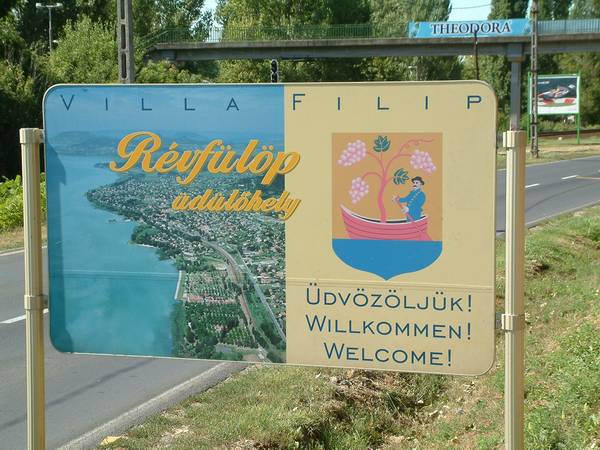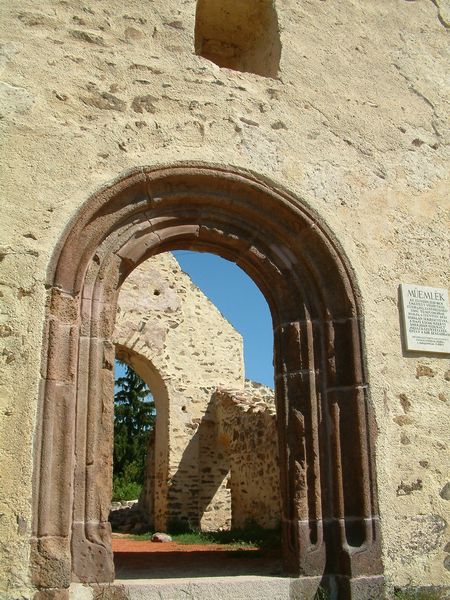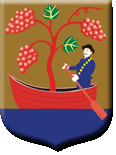
 Révfülöp, the holiday resort with its 1300 inhabitants, is situated on the picturesque north shore of Lake Balaton at the foot of the 274 metres high Fülöp Hill. The first written memories about Révfülöp originate from 1211, though according to the finds its territory was inhabited in Roman times, too. Its ferry was mentioned in the 11th century under the name of Pilip as part of the Tihany Benedictine Estate.
Révfülöp, the holiday resort with its 1300 inhabitants, is situated on the picturesque north shore of Lake Balaton at the foot of the 274 metres high Fülöp Hill. The first written memories about Révfülöp originate from 1211, though according to the finds its territory was inhabited in Roman times, too. Its ferry was mentioned in the 11th century under the name of Pilip as part of the Tihany Benedictine Estate.
At the south foot of Fülöp Hill can be found one of the oldest rock of Hungary, the clay slate, which is approximately 400 million years old and called 'pereszteg' by the local inhabitants.
The other typical rock is the red sandstone, which is often used as building material since it is frost-resistant and can be trimmed easily. Its crumbly parts are very rich in mineral substances which have provided favourable conditions for wine-growing on the slopes since thousand years.
 During the reign of King Árpád little fishing-village was established around the ferry. In the 13th century a little church was built of red sandstone. In 1548 cruel Turkish marauders starving for plunder burnt up the flourishing village which became totally uninhabited. But Fülöp destroyed in fire -like Phoenix - revived from its ashes from the 18th century.
During the reign of King Árpád little fishing-village was established around the ferry. In the 13th century a little church was built of red sandstone. In 1548 cruel Turkish marauders starving for plunder burnt up the flourishing village which became totally uninhabited. But Fülöp destroyed in fire -like Phoenix - revived from its ashes from the 18th century.
At the beginning of the 18th century beside the Tihany Benedictine Abbey new owners appeared in the territory and viticulure became flourishing again. In1752 ferry shipping was started again and in 1779 a new crossing point and ferry-house was built which was mentioned in the first Hungarian newspaper, the 'Magyar Hírmondó', too.
From the 19th century the name of the settlement derives from the personal name 'Pilip' (today Fülöp) and the early medieval ferry crossing point (in Hungarian 'rév'). The Fülöp-Boglár ferry taking the natural advantage of the relatively short distance ( 5,2 km) between the two shores connected the economically different territories.
From the late 19th century the prospering viticulture was ruined by phylloxera, in other words the grape-louse. The owners of the vineyards became poor so they sold their territories, wine-press houses and cellars. But from that time started the development of Révfülöp again.
Enthusiastic local people led by Károly Czigány supported the development of the village to be a bath- and holiday resort. Thanks to its natural endowments and picturesque beauty Révfülöp became a popular holiday resort at the end of the century. Mainly teachers, scientists, factory-owners, army officers and state officials established vineyards, villas and summer cottages in the village.
In 1899 the Beach and Shore Improving Association was founded which created the face of today's Révfülöp with beach and shore developing, landscaping and planting trees.
From 1909 Révfülöp was connected to the national railway network, from 1911 to the national telephone system and from 1936 to the electrical system. In 1912 the modern pier was built and a decade later a primary school was founded.Thanks to the spectacular developing in 1933 Révfülöp, which was part of Kővágóörs at that time, gained the holiday resort status and from the 1st January 1943 became independent settlement. From 1969 it became an outstanding holiday resort and the centre of the region.
The population of Révfülöp in 1757 was 193 people, in 1880 148 people, in 1910 276 people, in 1941 804 people, in 1960 1313 people, in 1980 1274 people and in 2000 1277 people. In 2001 the number of local inhabitants was 1280 people.
RÉVFÜLÖP NOWADAYS

The territory of Révfülöp is 1036 hectares. Due to its natural endowments the structure of Révfülöp is parallel with the shore of Lake Balaton and it can be devided into four different units.
- the territory between Lake Balaton and Road 71, where the parks, the pier and most of the places of entertainment can be found Szigeti strandfürdő és a Császtai strand.
- The territory above Road 71 which is a densely populated area with public buildings and servicing units.
- The vineyard on the slopes of Fülöp Hill which has decreased to its tenth, to almost 11,5 hectares for today.
- Forests on the top of Fülöp Hill.
The national road transport and the shape of Révfülöp is definitely determined by Road 71, which devides the ancient centre of the village from Lake Balaton. The local road network serves for the internal traffic. Almost every streets have asphalt surface and they are quite narrow. In the years past cycle path was built through the whole settlement.
Bus service with four bus-stops, railway system and in summer the passenger boats between Révfülöp and Balatonboglár, which can be found on the south shore of Lake Balaton, make public transport possible.
The centre of Révfülöp is situated between the Szigeti and the 'Császtai' Beach. On the slopes of the Fülöp Hill with summer cottages and villas careful wine-growers produce the
"Real friend - and marriage wine" - as Béla Hamvas depicted it.
According to Jenő Cholnoky the excellent geographer 'From the Fülöp Hill of Révfülöp you can enjoy one of the most beautiful landscapes of the world.
"From the Fülöp Hill of Révfülöp you can enjoy one of the most beautiful landscapes of the world."
Tourists visiting Révfülöp can experience themselves the fascinating panorama from the Look-out Tower on the Fülöp Hill which was built in 2001.
The region provides a lot of opportunities for trips: in the landscape-protection area of the Káli Basin natural curiosities - the 'Kőtenger' (stone-sea) of Kővágóörs, the crater-lakes of the Fekete Hill, famous springs - rich flora and fauna, and in the villages ethnographical and historical curiosities and cultural programmes attract visitors. After the attractive summer programmes (Villa Filip Days, concerts, the exhibitions of 'Tóparti' Gallery, the permanent exhibitions of the Local Historical Museum) and the trips the places of entertainment opened late at night and the fascination of night life provide recreational facilities.
At the beginning of the century Révfülöp discovered its 'mission': being a place for relaxation and entertainment much to the delight of people visiting Révfülöp.
Surely Révfülöp fulfils its mission since more and more tourists have been attracted by the village. Révfülöp would like to prove that urbanization and relaxation can be in harmony together since in the centre of its 'philosophy' stands the complete man with all his/her needs and desires. We know that tourists expect not only relaxation but physical-spiritual regeneration from the summer days as well.
Welcome to Révfülöp, you can trust in us,
Révfülöp - as its history proves - knows the secret of rebirth.